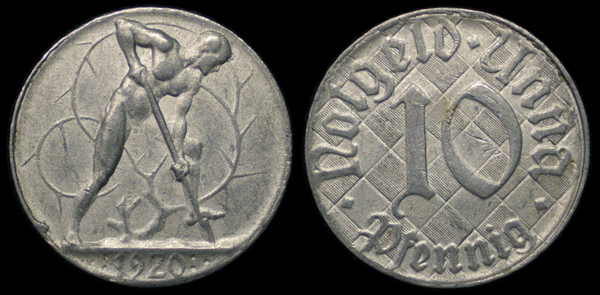
STADT UNNA (GERMAN) 10 PFENNIG 1920
L- 539.7 City of Unna (Westfalia) Aluminum 10 Pfennig Coin.
This coin was issued by the city of Unna in 1920 and was meant to be used as local small change or sold to raise funds. Unna released six previous issues, all in 1917. These early issues depicted the city coat of arms and were minted in both zinc and iron with 5, 10, and 50 pfennig denominations. The more artistic 1920 issues (above) were minted only in aluminum and only in a 10 pfennig denomination. On the obverse is the issue date and a stark scene of a man digging in the ground with a thorn bush in the background. Depicted on the reverse is the denomination and the name of the city on a checkered field.
Unna is a city of almost 70,000 people in North Rhine-Westphalia, located on the east end of the Ruhr river. It is also located on the old Hellweg road, an important ancient trade route.
Under the Holy Roman Empire it was part of the County of the Mark until that county was transferred to Prussia In 1701. In 1735 the local government of the area was reformed, creating the first district of Hamm. The area was held by France for a time during the Napoleonic conquests then regained by Prussia upon the defeat of the French Empire.
This coin was minted while the town of Unna was a part of the district of Hamm, After World War I and a few years before Hyperinflation set in. Restructuring saw the administration center relocated from Hamm to Unna in 1929. the Hamm district was then renamed as the Unna district to reflect that change.
Unna was a largely agricultural community until a shift to industrialization in the 19th century. Today Unna remains the district seat, a popular historic tourist destination, as well as the home to moderate business and industrial concerns.
